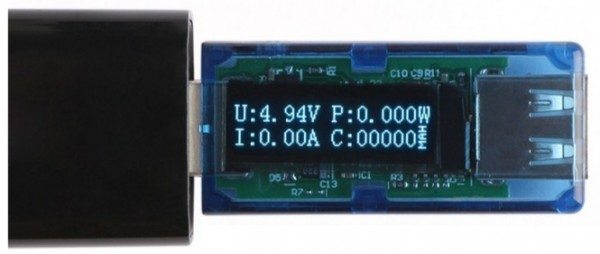Have you ever wondered why your cell phone is charging so slowly? Could it be an ill-suited wall charger, a bad mico-USB/lightning cable, or does your phone’s battery need replacing? Maybe you’ve wondered if there are truly any differences between different brands of micro-USB cables or how efficient your 10,000 mAh external battery charger is (there is always some loss due to inefficiency, but how much?). Perhaps you just need to detect the optimal position in the sun to charge your solar battery. All of these things can be determined by using a device referred to as a USB charge doctor, USB detector, USB meter, USB multimeter, USB power meter, USB current meter, USB voltage meter and a few others. These devices are connected inline where they receive their power (no battery necessary) and will give you voltage, current, and sometimes power readings. The one shown in the above photo is the DROK Micro OLED Meter Voltage Current Charger Detector. Most of them are the size of a thumb drive and have a USB A male connector on one side that can be inserted into a charger (AC adapter, desktop multi-port charger, external portable battery, or computer/laptop) and a USB A female port on another side in which a charging cable connected to your device can be inserted. They also have displays that will show you the readings.
There are several kinds available. Here are just a few from Amazon:
- DROK Micro OLED Meter Voltage Current Charger Detector – $14.53
- PortaPow USB Power Monitor Version 2 – $14.99
- Jellas™ LCD Digital DC Multimeter/USB Meter/Voltage & Current & Wattage & Mah Meter – $9.99
- BESTOPE® USB Mini Charger Doctor, Current Test Tool, Voltage Test Tool, Amp Volt Reader – $11.99
- AboveTEK® USB Power Meter USB Current Meter – $13.95
PretzelLogix.net provides an informative review of four USB multimeters, three of which are listed above. When purchasing such a device, you should consider the voltage range as well as current range. This is important in cases where you may want to plug the USB multimeter into a power source that supplies a higher voltage such as some Quick Charge 2.0 devices. Doing this can damage the multimeter if it is not rated to handle the higher voltage (the same would be true for current). Many of the USB multimeters support 3V – 7V while the above DROK device supports 3.7V – 13V (the specifications of this DROK USB multimeter state that it supports Quick Charge 2.0 technology and is compatible with 5V, 9V, and 12V power sources). Please click on the above links for more information.




Gadgeteer Comment Policy - Please read before commenting
Very cool Kathleen! Thank you for this heads up. I didn’t know these type of gadgets existed! I followed your link to the PretzelLogic review and read how they recommended the DROK. I clicked on their link to purchase a DROK from Amazon. I noticed there is a USB 3.0 version for quite a bit more money (almost $40), but I will buy that one since USB 3.0 is becoming so common now.
@CraigH – I’m glad I could help out! I saw the DROK USB 3.0 multimeter that you are talking about, but I didn’t buy that one because the specs reported that it supported only 3-7V and I wanted one that supports the higher voltages that you can have with Quick Charge 2.0 power supplies (although I did notice that sometimes the specs reported on these devices are incorrect). Anyway, I hope it works well for you and let me know what you think of it when you receive it!
When I said the specs reported are sometimes incorrect, I only meant my own device when reporting the voltage range (the device I have supports 3.7-13V, but elsewhere in the description on Amazon it said my device supports 3.7-10V, which is incorrect). I hope I didn’t worry you – what you are purchasing is indeed a USB 3.0 multimeter.
Hi Kathleen—Thank you for pointing that out! I went to the DROK website to see if they had a PDF manual of the devices. They did not, so I posted a comment asking them if the 7V maximum voltage on the newer 3.0 version was a mistake. We will see what they say. It wouldn’t make sense to make a newer USB tester have a lower maximum voltage than their older USB tester.
Regarding the “17000 Ah for the 9 volt variety” (17000mAh x 9v) / 1000 = 153Wh making this device below the 160Wh FAA (101-160v) requirement. “With airline approval, passengers may also carry up to two spare larger lithium ion batteries (101-160 watt hours)”.FAA’s current requirements:https://www.faa.gov/about/initiatives/hazmat_safety/more_info/?hazmat=7As of today, Delta authorizes up-too (160wh) without prior consent.”Size Limits for Lithium Batteries:Passengers are permitted to travel with lithium ion batteries that contain a maximum of 160 watt hours per battery. Any lithium ion battery containing more than 160 watt hours is prohibited from carriage on all passenger aircraft. Lithium ion batteries installed in a personal electronic device can be transported as checked or carry on baggage. Lithium ion batteries not installed in a device (spares) must be in carry-on baggage and no more than two (2) spares between 100 and 160 watt hours are allowed.”Delta’s Restricted / Approved Item’s:http://www.delta.com/content/www/en_US/traveling-with-us/baggage/before-your-trip/restricted-items.htmlAlso, please correct me if I’m wrong so I don’t make a mistake!
Jose – Perhaps you meant to submit this comment to a different news post or review? It does not seem to apply to this post.
However, your statements about the FAA and airline rules for the maximum allowed size of external lithium ion batteries appear to be correct based on the information in the links you provided. Thanks for sharing this!